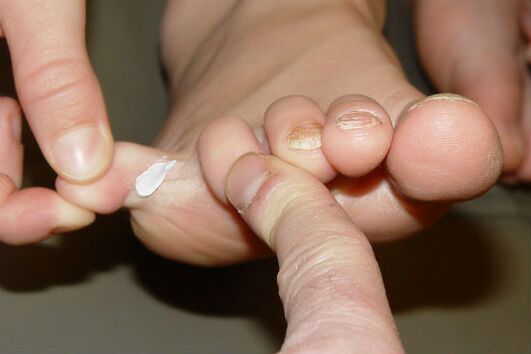
As spores multiplythe fungus spreads to the skin of the feet and nails, penetrates through microcracks in the blood and is transported with the bloodstream to all internal organs.
What type of fungus develops on the toes?
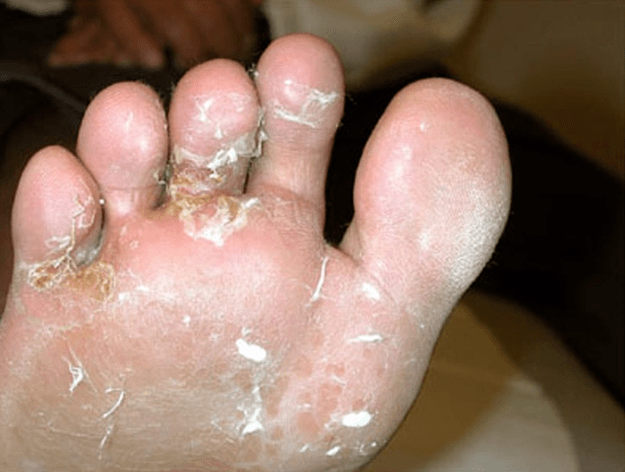
- Toe mycosis is caused by the pathogenic anthropophilic organism Tinea pedis.. . .
- Less commonly, the causative agents of the disease are molds and yeast-like fungi of the genus Candida.
- The favorite habitat of the fungus is the folds of skin between the fingers, where it is warm and humid.
- As the microorganism multiplies, the spores of the microorganism also spread under the toes and then throughout the foot.
- Primary infection with the fungus occurs in public places: bathrooms, swimming pools, saunas, in gym locker rooms.
- Microorganisms perfectly tolerate low temperatures, excessive drying of the surface, they can persist for a long time on clothes, carpets, shoes, and, if the opportunity arises, adhere to the skin of the feet.
- Often, the transmission of the organism occurs within the family., when using general hygiene items, slippers, manicure tools.
- When in contact with the skin, microorganisms can remain dormant for a long time. Active spore growth begins with the appearance of favorable conditions, that is, with a decrease in the immunity of an infected person.
- If the spores come into contact with the skin of a person suffering from a chronic disease or who does not follow hygiene rules, the development of mycosis begins almost immediately.
- It is especially important that patients with chronic diseases know what the fungus looks like on the fingers, since they are infected with the pathogen more often.

- malfunction of the endocrine system;
- poor circulation in the extremities, phlebeurysm;
- flatfoot,contributing to greater friction of the skin;
- systematic stress;
- periods of hormonal changes in the body: pregnancy, menopause, adolescence;
- inflammation of the lymphatic system;
- postoperative or post-traumaticlowered immunity. . .
The growth of the fungus is favored by sweaty feet, shoes made of synthetic materials, and micro-injuries to the skin.
Favorable conditions for the growth of spores are created with improper nutrition: the abuse of sweets, flours, fatty foods, alcoholic beverages.
Toe fungus is rarely diagnosed in children. The main cause of mycosis in a child is poor hygiene.
Symptoms and forms of the disease
It is possible to suspect the development of a foot infection in the initial stages even before the appearance of visual signs of mycosis.The first sign of infection is peeling and itchy skin.. . .
When microorganisms begin to invade the epidermis, the surface of the fingers becomes covered with small scales and cracks.
An unpleasant odor emanates from the feet. Specific symptoms depend on the form of the disease:
- Erased.Small cracks and slight peeling form under the fingers and on their surface.
- Squamous-hyperkeratotic.There is severe itching, burning, white crusting on the fingertips.
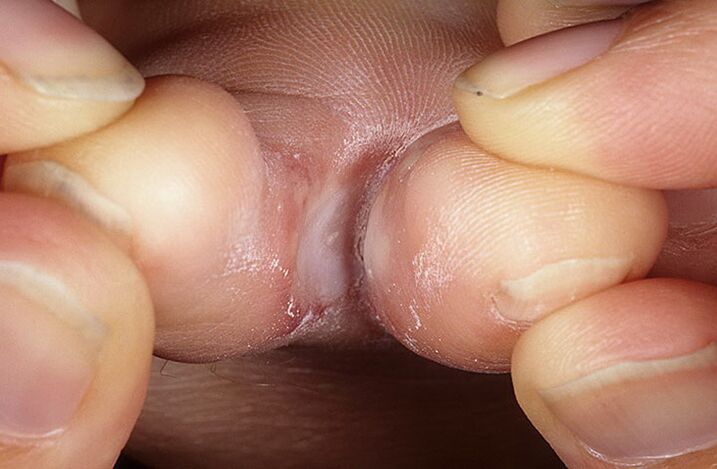
- Intertriginous.There is swelling, redness of the skin, the formation of moisture between the fingers, peeling of the skin, the formation of deep cracks.
- DyshidroticIt is manifested by the eruption of small vesicles filled with serous fluid. Intense itching, erosion formation at the place of bursting bubbles, the whole foot becomes inflamed.
IMPORTANT! In the later stages of the disease, the fungus penetrates the surface of the nails and begins to change their color and structure. Nails are covered with colored spots, deformed, crumble.
Diagnostics
- When the first clinical signs of infection appear, it is necessary to consult a doctor for a diagnosis.
- Despite the fact that the symptoms of the fungus are clearly visible even in the photo,only a specialist can identify a specific pathogen.
The patient is prescribed laboratory tests:
- Microscopy of cutaneous particles.
- Bacterial culture of scrapings and vesicle fluid.
- Biomaterial DNA research.
- Blood test.
Treatment
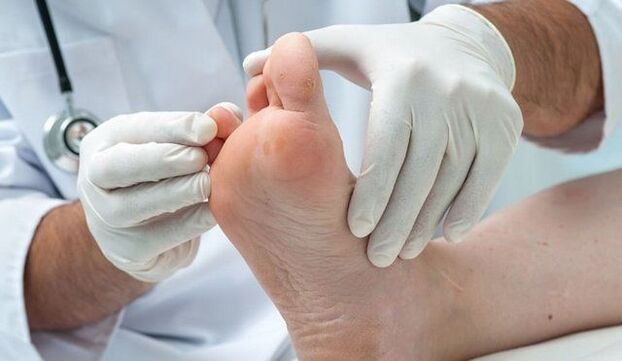
- The main activities are:thorough skin hygieneand treatment with topical antifungal drugs.
- In the later stages of the development of a yeast infection, doctors prescribe antifungal medications by mouth.
- As a supplement to medication, folk remedies and physiotherapeutic procedures are used.
- It is possible to cure toe fungus by carefully following the doctor's recommendations, without reducing the time it takes to take prescribed medications.
Medicine
Drug treatment involves the use of two groups of drugs:
- External preparations: ointments, creams, gels, sprays.
- Preparations for oral administration.
IMPORTANT! The complex of therapeutic measures also includes a special diet, which takes immunostimulants and means to restore the intestinal microflora.
Physiotherapy
Physiotherapy procedures, in addition to drug treatment, accelerate the healing process:
- UV irradiation of the skin. . . The rays penetrate the skin to a depth of 0. 6mm and kill the fungal spores in it. The duration of the sessions is 15 to 20 minutes. In the early stages of infection, the use of ultraviolet radiation avoids the use of antifungal agents.
- Diathermy,amplipulse therapy, UHF therapy to improve peripheral circulation.
- Laser irradiation of the skin.. . . Skin irradiation suppresses inflammation, relieves itching, dries wet areas.
Traditional methods
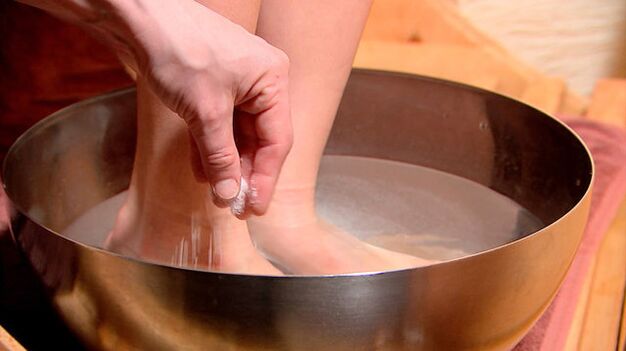
As adjuncts to drugs, prepared according to popular recipes, they are quite effective.
Based on reviews, the following provide effective assistance:
- Baths with soda and salt.. . . 1 tablespoon. l. salt and soda are dissolved in 2 liters of water, 10 drops of iodine are added. The feet are soaked in the solution for 15 minutes. The procedure is carried out before applying the antifungal agent.
- Trays with potato skin decoction. . . The broth is immersed in the broth, which is otsuzhenny at a comfortable temperature, for 20 minutes, then washed off. The procedure is done daily until symptoms disappear.
- Trays with aspen bark decoction. . . 100 g of minced bark are poured into 500 ml of boiling water and it is insisted until cool. The resulting infusion is added to the bath.
- Garlic ointment. . . 2 large garlic cloves are crushed until they obtain a state of mush and mixed with 100 grams of butter. The ointment is applied to the skin by steaming for 10-15 minutes daily for a month.
- Decoction applicationsmedicinal herbs. A series of chamomile and violet is poured, 2 tablespoons each, with a liter of boiling water and insisted for 2-3 hours. Infusion-soaked gauze is applied to inflamed areas for 30 minutes a day.
- Compress with burdock leaf. . . A fresh burdock leaf is struck with a hammer, the legs are wrapped, secured with a bandage, and the socks are put on. The compress is changed 2 times a day. The duration of the course is 21 days.
- Carrot juice applicationsand vinegar. 1 tablespoon. l. Carrot juice and 9% vinegar are mixed and applied with a tampon on the inflamed areas.
- Egg and vinegar ointment. . . A raw egg is poured with 100 ml of vinegar essence (70%) and it is insisted for 7 days. Mix the dissolved egg with 100 grams of butter, beat. The resulting emulsion is spread with steamed legs, wrapped in aluminum foil and put on socks. The procedure is repeated every day until the fungus is completely healed.
- Compress with ammonia. . . Add 1 tablespoon to 200 ml of water. l. ammonia, moisten gauze in a solution, wrap your feet and put on socks. The compress is done at night and left until morning. The total number of procedures is 9-10.
Several interesting recipes for the treatment of fungi. The use of traditional medicine methods necessarily requires the permission of the attending physician.
Complications
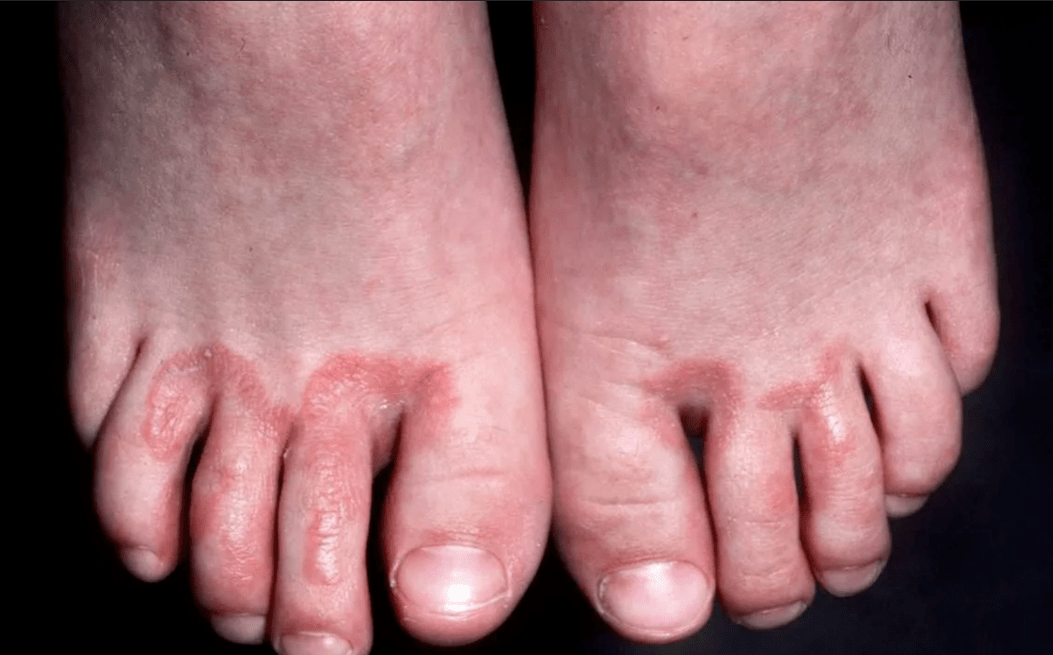
By spreading through the body and entering the bloodstream, the infection affects the internal organs and has a negative effect on the functioning of the entire organism:
- Prolonged exposure to fungal toxins causes allergic reactions, exacerbation of bronchial asthma, dermatitis.
- Penetration into the blood disrupts the work of internal organs.
- Deep mycosis causes the progression of diabetes mellitus and, in its context, gangrene and bone infection can develop.
Prophylaxis
An organism with a strong immune system is able to resist any infectious disease. Therefore, the main measure to prevent fungal infection is to maintain the body's defenses.
Compliance with the rules of hygiene will help to avoid infection with fungal spores:
- dailychange of stockings and stockings;
- wearing breathable shoes made of natural materials;
- wearing special shoes(slippers, slippers) in public places;
- foot skin treatmentspecial protective sprays when visiting swimming pools, baths, beaches;
- performing a pedicurein a proven salon,where instrument disinfection is done correctly;
- trying on shoes in a storein disposable socks. . . To prevent spores from persisting on various surfaces, it is necessary to treat them antiseptically with a 45% vinegar solution.It is recommended to replace towels and slippers.Treat the rest of the shoes from the inside with a vinegar solution and put them in a plastic bag for 12 hours.
- Boil bedding, socks, hosiery, and towels for 10-15 minutes in a soap and soda solution.
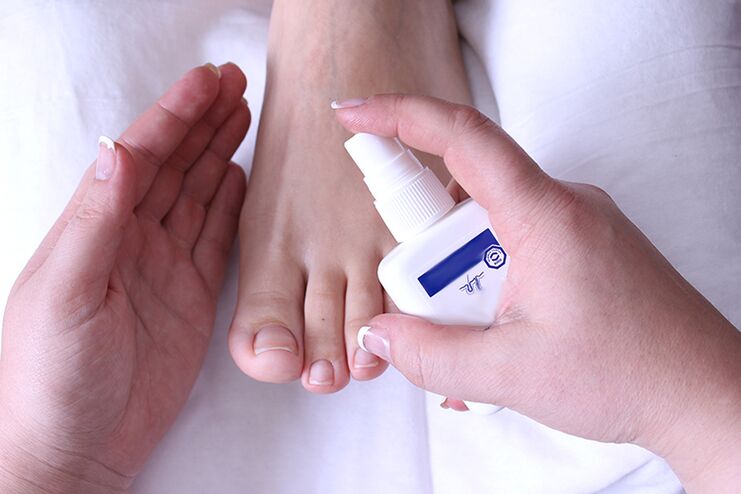
Toe fungi should not runtherefore, when the first symptoms appear, it is recommended to consult a doctor.
Timely treatment started will allow you to quickly cope with the fungus and avoid complications. It is necessary to treat the mycosis until the symptoms are completely eliminated and the skin recovers.
Fungi on the little finger: causes, symptoms (PHOTOS) and treatment methods
Toenail or toenail fungus always begins with the defeat of the outermost toes.
Most of the time, the big toe is the first to suffer, as your nail is the largest in size, but in some cases, the fungus appears first on the little finger.
Such onychomycosis is dangerous because of the rapid destruction of the nail plate, which is associated with the small size of the nail on the little finger.
The reasons for the development of the disease
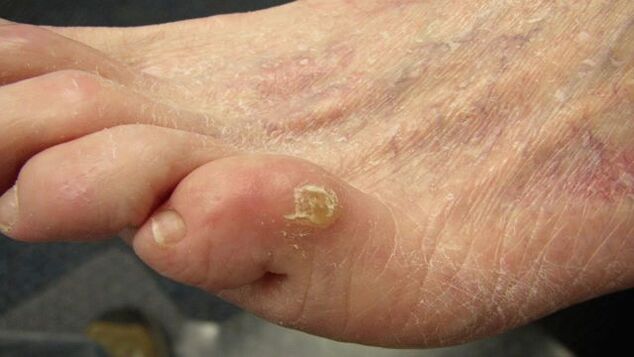
Toenail fungus most often begins with damage to the outside of the fingers.
The fungus on the little finger is the result of poor personal hygiene when visiting public places. Fungal spores come into contact with the skin in public showers and swimming pools. This is due to the fact that the fungus actively reproduces in a hot, humid environment.
Another reason for the development of the disease is profuse sweating and microtrauma of the nail plate. In this case, you can get the disease by trying on shoes, using other people's towels, or manicure tools.
The fungus on the little finger of the hand occurs most often due to contact with an infected person. A careless handshake can cause spores to crawl under the nail plate.
The main condition for the development of the disease is a decrease in immunity, both general and local. Hyperhidrosis, trauma and damage, circulatory disorders in the extremities - all this leads to a decrease in local immunity and increases the risk of infection.
The peculiarity of the fungal infection of the little finger is the rapid development of the disease. Onychomycosis is caused by fungi that feed on keratin, which is a building material for nails.
The smaller the nail, the faster the pathogenic microflora will destroy it, destroying the keratin, which means that the infection will spread quickly to healthy nails.
If, with a lesion on the thumb nail, the disease progresses slowly and the symptoms increase over months, with onychomycosis on the little finger, the symptoms are noticed within a week after the spores of the fungus get under the nail .
How to recognize a disease?
The characteristic symptoms of fungus on the little finger of the nails depend on the exact localization area. The fungus can affect both the nail and the finger or interdigital spaces. In the first case, the symptoms are as follows:
- yellowing of the nail;
- thickening of the nail plate;
- the appearance of grooves and cracks;
- severe deformation of the nail.
A thick discharge with an unpleasant odor may appear under the nail. The adhesion of the infection is accompanied by purulent discharge. If left untreated, over time, the nail completely collapses and falls off the nail bed.
When the skin of the finger is affected, the following symptoms are observed:
- redness of the skin;
- severe itching;
- severe flaking;
- the appearance of an unpleasant odor.
Fungi on the little finger are a serious threat to all other healthy fingers, as the spores spread very quickly to healthy skin. In an advanced case, the fungus affects the interdigital spaces, the nail plates and the skin of the foot. All this is accompanied by severe itching and an unpleasant foot odor.
Diagnostics

If you notice a change in the nail or skin of the little finger, you should visit a dermatologist. The doctor will examine and take the scrap for analysis. In the case of skin lesions, scaly scales are sent to the laboratory, which are easily separated from the skin.
If the nail plate is affected, the doctor will cut a small piece of the nail and take a swab of exudate under the nail plate. This material is sent to the laboratory for microscopic analysis. Based on the studies conducted, the optimal treatment regimen is selected.
Treatment principle
To treat the fungus on the little finger, external antifungal agents are used. To get rid of the disease faster, you need to:
- control personal hygiene;
- take regular foot baths;
- treat the skin around the affected area with an antiseptic;
- improve immunity.
To prevent the spread of fungal spores to healthy nails, separate manicure tools should be used for the affected finger; disposable files are the best. It is imperative to treat the affected area with special products daily, wash your skin thoroughly, perform an antiseptic treatment, and wear only socks and shoes made of breathable natural materials.
Drug treatment
In the treatment of fungal diseases of the feet and with a fungus of the little finger, agents for external use are used, supplementing the treatment with antiseptic baths. In severe cases, the doctor prescribes pills for the fungus.
Only a doctor can choose the exact drug after testing. The listed medications are effective against yeast and mold. The cream should be applied twice a day to previously washed and dry skin. In this case, the agent should be applied not only to the affected skin, but also to the healthy epidermis around the infected nail.
To avoid the spread of spores to areas of healthy skin, it is necessary to also use antiseptics. For this, hydrogen peroxide, a solution of potassium permanganate or iodine is used.
Funds in the form of varnish remain on the nail plate for a long time, which ensures the effective destruction of pathogenic microflora and prevents further spread of fungal spores.
Treating nail fungus takes a long time. On average, the course of therapy lasts 9 months. You can stop using drugs only after a healthy nail has grown.
Before applying the varnish, the nails should be steamed, filed and degreased with an alcohol solution or napkins containing alcohol.
In the initial stage of onychomycosis on the little finger, you can use powerful antifungal creams. The drug is applied after a foot bath and pedicure. In order for the drug to penetrate deeper into the nail plate, it must be carefully sanded, removing all microcracks.
In severe cases of onychomycosis or if the disease recurs, the doctor may prescribe pills. They have a systemic effect throughout the body, helping to fight pathogenic microflora from within.
Remove the nail

The nail of the little finger is small in size, almost invisible, and grows back quite quickly, so the doctor may recommend a radical treatment method - removal of the nail infected with the fungus. The procedure itself is quick and painless. There are also special kits with uric acid that soften the nail and promote its independent separation from the nail bed.
After removing the nail, a special ointment and bandage is applied to the finger. After 5-7 days, a scab forms under the bandage and can be removed. The nail will start to grow back in about a month. During all this time, it is necessary to use antifungal agents to prevent reinfection.
The benefits of removing the nail plate minimize the risk of contamination from healthy nails. This allows you to get rid of the fungus in a day, but you will have to wait until the nail grows back completely. On average, a nail on the little finger is fully restored in 3-4 months.
Home remedies
It is advisable to use home remedies for the milder forms of the fungus. They help to prevent the spread of pathogenic microflora spores to healthy fingers, therefore, they perfectly complement drug treatment.
- Lemon juice effectively removes yeast. It can be used for the infection of the nails with the Candida fungus, for this it is enough to cover the nail with lemon juice twice a day.
- Mushroom paste will help to beat the disease. To prepare the product, you must mix a teaspoon of baking soda with the same amount of water and apply on the nail under a compress. The compress should be kept for half an hour, the procedure should be repeated twice a day until the symptoms completely disappear.
- The basis of the popular treatment of the fungus is formed by baths. They can be made with iodine, baking soda, salt, hydrogen peroxide, powdered boric acid, or herbs. For every liter of water, you should take a tablespoon of the chosen product. Bathing should be done daily before going to bed for 20 minutes.
Folk remedies perfectly prepare the skin and nails for applying ointments from the fungus. As an independent remedy, they are ineffective, so you cannot completely trust traditional medicine.
How to avoid getting infected?
Preventing yeast infection comes down to personal hygiene. You should always wear slippers when visiting public showers and swimming pools, don't use someone else's towels or wear someone else's shoes.
If a person has contracted a foot fungus once, antifungal creams should be used regularly for prevention. To do this, just apply them to the skin 1-2 times a week.
Foot hygiene plays an important role in protecting against fungi. It is necessary to wash your feet daily with antiseptic or tar soap, wear only socks made from natural fabrics, and choose comfortable shoes made from breathable materials.
Fungus between the toes: symptoms (PHOTOS), the best ointments and home remedies for treatment.
Among all types of fungal diseases, foot injuries are the most common.
One type of foot fungus is a fungus between the toes. The disease causes severe itching and peeling of the skin, causing severe discomfort. You can get the fungus in any public place with high humidity.
This type of mycosis occurs in both adults and children.
The reasons for the development of the disease
The fungus between the toes is a type of foot fungus. The disease is contagious and difficult to treat. The course of therapy can last several months.
The fungus between the toes develops for the following reasons:
- non-compliance with foot hygiene;
- visit public places with high humidity;
- wearing someone else's shoes;
- using someone else's towel.
The easiest way to get an infection is to go to public showers without the proper protective equipment. The absence of individual slippers in a shared shower, a gym locker room or even in a sauna with a moderately high temperature, can cause a fungal infection between the toes, a photo of the symptoms of which you will not doubt the nature of the peeling of the skin.
The development of fungus between the toes of a child and an adult can be caused by neglect of personal hygiene. Lack of proper foot care causes the accumulation of sweat and dirt in the interdigital spaces.
This is a favorable breeding ground for the fungus.
Since some pathogens are always present in the human body, the development of fungal microflora on the skin can occur even without contact with a potential source of infection.
The fungus of the feet and the skin between the toes is a very contagious fungal infection. You can get sick by trying on someone else's shoes, if a person is infected. This is due to the fact that fungal spores settle on the inner surface of the shoe and easily reach healthy skin.

You can get sick even if a family member is fighting a yeast infection. The fact is that the spores of the pathogenic microflora settle on everything that came into contact with the affected skin. The spores persist in carpet pile, towels, and bathroom and shower surfaces. The slightest contact with these objects is enough for the spores to penetrate healthy skin.
However, not everyone gets the fungus from using someone else's towel or shower. Factors that provoke the development of fungus between the toes:
- decreased immunity, both general and local;
- the presence of damage to the skin of the feet;
- profuse sweating;
- long-term use of antibiotics;
- frequent stress;
- wearing too tight shoes;
- diseases that cause poor circulation in the lower extremities.
Long-term drug therapy and frequent stress weaken the body, making it vulnerable to various bacteria and fungi. Wearing narrow shoes leads to a violation of local blood circulation, which reduces the immunity of the feet. This creates favorable conditions for the rapid development of pathogenic microflora.
The fungus of the foot and the interdigital spaces is especially susceptible in people with diabetes, cardiovascular diseases and varicose veins of the lower extremities. All these pathologies lead to a deterioration of local metabolic processes and a violation of cellular immunity, which increases the risk of infection by a fungus.
Factors that provoke the development of the infection include the use of very tight shoes made of low-quality materials, synthetic socks, and profuse sweating. All this creates a favorable environment for the development of pathogenic microflora. With profuse sweating, the process of increasing the population of fungi is accelerated, since this microflora loves a warm and humid environment.
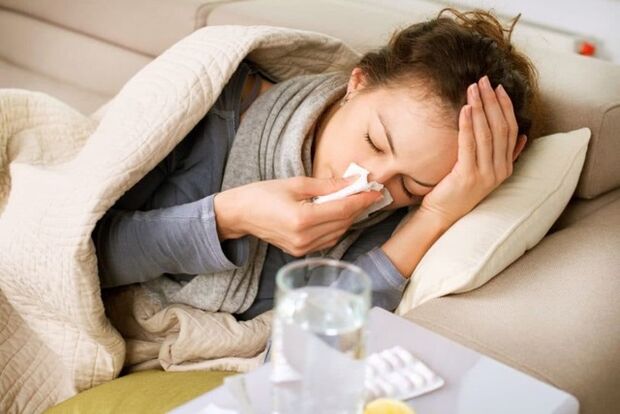
Home remedies
Traditional medicine knows how to get rid of the fungus between the toes. For this, it is proposed to use trays and solutions for skin treatment.
- Pour 2 sachets of boric acid into a bowl of water and place the feet for 20 minutes. Apply every two days.
- An effective bath for mycosis: 4 liters of hot water, 2 tablespoons of soda, salt and iodine. Take 15 minutes, then lubricate your feet with medicated ointment.
- You can use applications of a vinegar soda solution. To prepare the product, dissolve a teaspoon of soda and vinegar in half a glass of water. Then a cotton swab is moistened in the solution and the skin is thoroughly treated.
For the daily hygiene of the feet, it is recommended to use tar or soap for washing. They perfectly degrease the skin and have a weak antifungal effect.
Preventing the development of fungus between the toes is a complete hygiene of the feet. It is important to always bring your own rubber slippers to the pool, gym and sauna. You should not use other people's hygiene items or try on a stranger's shoes, as they may contain fungal spores.
From all that has been said, we can conclude that foot fungus is an extremely dangerous disease. The consequences of the disease can be extremely negative for human health. Do not self-medicate so as not to cause complications.















